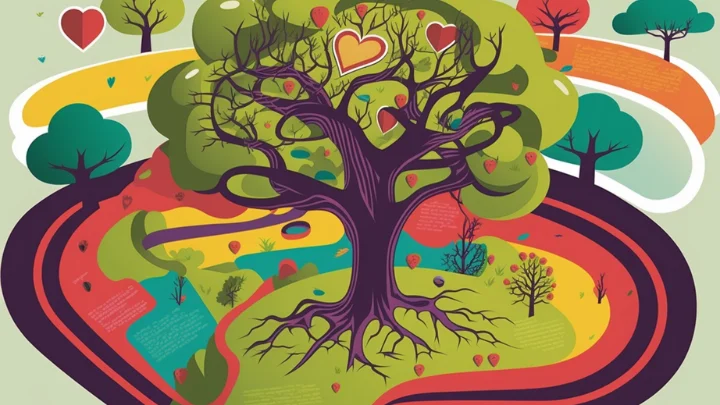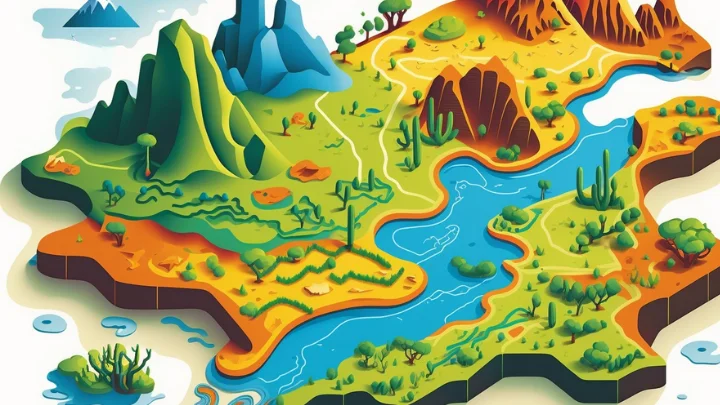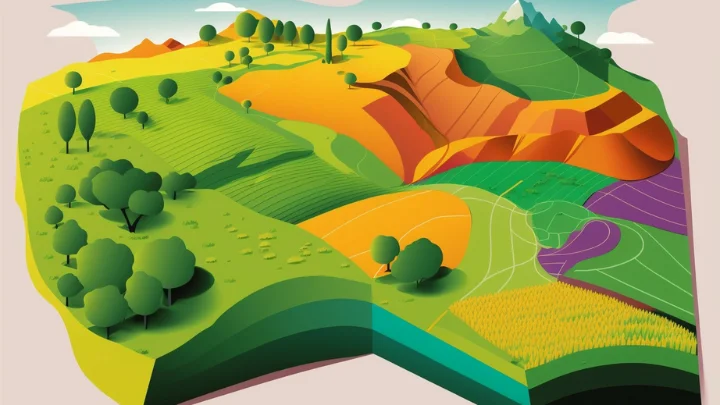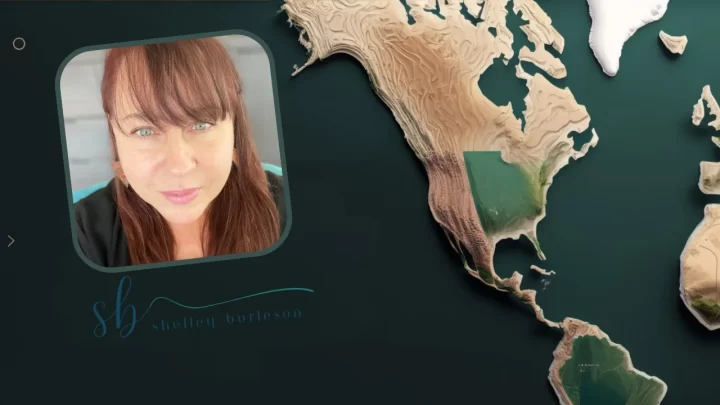This post may contain Amazon affiliate links which means, as an Amazon Associate, I may receive a small commission from purchases made through these links at no cost to you. I only recommend products I have personally used. To learn more, please see my privacy policy page.
Physical geography is the study of the Earth’s natural features and processes, for example landforms, climate, water bodies, and soils. It explores how these elements interact and vary across locations, and it is an integral part of understanding our planet’s past, present, and future conditions.
Key Words
- biogeography
- climatology
- fieldwork
- geography
- geomorphology
- hydrology
- landforms
- natural hazards
- remote sensing
- scale
- scientific method
- soil geography
- spatial data
But that’s just the surface. Dive deeper with me as we explore examples of physical geography in action, its essential role in today’s world, and how you can get involved in this expansive field. Your journey into understanding the Earth more deeply starts here, and I’m your guide every step of the way. Read on…

What is Physical Geography?
Physical geography focuses on the natural features and phenomena that define physical geography of the Earth. It seeks to answer the ‘where’ and ‘why’ of the world around us—where do certain types of plants grow and why? Where are different landforms located and why do they form there? The physical geography definition encompasses everything from the vast patterns of global climate down to the microscopic minerals in the soil beneath our feet.
Understanding physical geography is not just about satisfying our curiosity. It is essential knowledge that influences our daily lives, affects our future, and helps us to be responsible caretakers of our planet. In an era of climate change and increasing natural disasters, physical geography focuses on crucial insights for solving some of the world’s most pressing problems and understanding natural phenomena.
In this beginner’s guide, we are introducing physical geography and embark on a journey to understand what it is, its key characteristics, examples of its various studies, and why it is an indispensable field of science. Whether you are a student, a curious reader, or someone looking to understand the world better, this guide is for you. If you are asking yourself “What is geography, though?” take a look at this article I wrote.
Describing Physical Geography
Physical geography is a dynamic and diverse field that goes far beyond simply mapping and naming the components of a landscape. It is a science that seeks to understand the why and how behind the world’s various environments, from the icy tundra of the Arctic to the tropical rainforests of the Amazon.
Physical geographers are like detectives for the Earth, using a wide array of tools and approaches to solve the mysteries of the natural world. They analyze data, make connections, and draw conclusions that help us to comprehend the complex interactions that shape the Earth’s surface.
Let’s take a closer look at the unique characteristics that set physical geography apart as a critical scientific discipline.
Holistic nature: Physical geography is holistic in nature, which means that it seeks to understand the complete picture of the Earth’s surface and the interconnectedness and interactions of its various components. It does not focus on one isolated system or feature but considers how various systems—like climate, landforms, and ecosystems—interact and shape each other.
Spatial patterns: One of the defining characteristics of physical geography is its focus on spatial patterns and relationships. Geographers use maps, GIS (Geographic Information Systems), and other tools to analyze where things are located in the world and why they are there. They study the spatial distribution of climates, rivers, mountains, soils, and more, and seek to understand the factors that create these patterns.
Temporal scale: Physical geographers examine processes and phenomena at various time scales. They may study recent events, such as a single storm or wildfire, but they also delve into longer timeframes, examining how landscapes evolved over thousands or millions of years. This allows them to understand both short-term incidents and long-term trends.
Scientific method and fieldwork: Physical geographers use the scientific method, involving hypotheses, data collection, analysis, and conclusion. Fieldwork is a fundamental aspect of physical geography; physical geographers often venture into the environment—be it a remote mountain range or a bustling city—to collect data. They might measure soil moisture, collect rock samples, or use drones to map a changing coastline. You can use fieldwork log or notebooks to collect data and observations. This one, for example, is for climate data – ‘in the FIELD: A Geographer’s Climate Notebook.‘
Tools and technologies: Modern physical geography is a highly technical field. Geographers use a range of advanced tools, such as remote sensing (using satellites or drones to gather data about the Earth’s surface), GIS (software that allows for the analysis and visualization of spatial data), and computer modeling (to simulate and predict future changes).
Interdisciplinary connections: Physical geography does not exist in a vacuum. It is deeply connected to other scientific disciplines. For example, geomorphology (the study of landforms) is closely tied to geology, while biogeography (the study of the spatial distribution of organisms) is related to biology. This interdisciplinary nature allows physical geographers to tackle complex, multifaceted problems.
Applied and practical focus: Physical geography is not just an academic pursuit; it has a strong applied focus. The insights gained through physical geographic research are used in a variety of practical applications, from natural disaster management and environmental conservation to urban planning and sustainable agriculture.

Beyond the Map
In an increasingly complex and interconnected world, understanding the physical aspects of our planet is more than an intellectual pursuit—it is an urgent necessity. The discipline of geography holds a magnifying glass to the Earth, allowing us to observe the dynamic relationships between the natural environment and human societies. It provides the knowledge and tools needed to address some of the world’s most critical challenges, from climate change and natural disasters to the sustainable use of precious resources.
In this section, we explore the pivotal role that physical geography plays in shaping our responses to these challenges and in fostering a harmonious and sustainable relationship with our planet.
Understanding Our Planet: Physical geography provides us with the tools to understand the natural environment in which we live. It helps us make sense of the diverse landscapes, Earth’s landforms, water resources, climates, and ecosystems around the world. Without this foundational knowledge, we would be ill-equipped to appreciate or care for the world around us.
Climate change: In a time when climate change is one of the most pressing issues humanity faces, physical geography plays a pivotal role. It helps us understand the mechanisms of climate systems, predict changes, and assess the impacts of human activities on the global climate, thereby informing our strategies for mitigation and adaptation.
Natural disaster management: Physical geographers study the processes and natural phenomena that lead to natural disasters such as hurricanes, tornados, earthquakes, volcanos, and floods. Their work is crucial in predicting where and when these events might occur, helping communities prepare for and respond to disasters, ultimately saving lives and reducing damage.
Sustainable development and conservation: As we strive for sustainable development, understanding the Earth’s physical landscape is paramount. Physical geography and environment informs land use planning, natural resource management, and environmental conservation, guiding us toward more responsible and sustainable practices.
Global perspective and connections: Physical geography helps us see the world as an interconnected system. It encourages a global perspective, showing us that actions in one part of the world can have far-reaching effects elsewhere. This is vital in our globalized world.
Informing policy and decision making: Physical geography’s evidence-based approach is essential for informing policy at various levels of government. Geographers’ analyses and insights are used to shape policies related to land use, water management, disaster risk reduction, and more, contributing to more effective and equitable governance.
Education and public awareness: By educating the public about the physical world, geographers play a role in both education and fostering a society that is more informed and engaged with environmental issues. This education is a steppingstone towards a more sustainable and conscientious future.

Branches of the Discipline Tree
Physical geography is a multifaceted field with a multitude of specialized areas of study. These other disciplines, which often intersect with various scientific fields, showcase the rich and interdisciplinary field of physical geography.
Here, we will explore a selection of these intriguing branches:
Geomorphology: the sub discipline of geography that studies landforms and the processes that shape them. From the soaring peaks of mountains to the meandering paths of rivers, geomorphologists decode the Earth’s surface and reveal the stories behind our planet’s diverse landscapes.
Climatology: studies the long-term patterns and averages of weather. This branch is essential for understanding climate change, predicting weather trends, and analyzing how climate impacts ecosystems and human societies.
Hydrology: focuses on water resources in all its forms and its journey through the hydrological cycle. This subdiscipline is critical in addressing issues like water scarcity, water resources, flood management, oceans, and water quality—a key facet of environmental health and human survival.
Biogeography: studies the distribution of species and ecosystems in their environments across geographical space and through time. From guiding conservation efforts to predicting the impacts of climate change on biodiversity, biogeography is key to understanding life on Earth.
Soil geography: involves the study of soil, its formation, classification, mapping, and description. As the foundation for agriculture and a critical component of the Earth’s ecosystems, understanding soils and soil erosion is key for food security and environmental conservation.
Landscape ecology: dives into the relationships between spatial patterns and ecological processes. This branch studies the ways in which landscape composition and structure affect the distribution and flow of energy, materials, and organisms across multiple scales. It bridges physical geography with ecology, and it plays a critical role in informing land-use planning and conservation efforts.
Natural hazards and disasters studies: This subdiscipline investigates extreme, sudden events caused by environmental processes. It is essential for preparing for and mitigating the impacts of disasters like volcanos, earthquakes, tornados, hurricanes, floods, and wildfires, aiming to safeguard communities and reduce damage.
Remote sensing and Geographic Information Systems (GIS): Remote Sensing and GIS are technological tools that have revolutionized geography. They enable geographers to collect, analyze, and visualize geographic data, providing an unparalleled perspective on our world’s physical, natural, and human landscapes.
The subdisciplines highlighted above represent just a snapshot of the diverse and dynamic field of physical geography. There are numerous other areas of specialization for many geographers, each offering unique insights into the complex interactions shaping our planet. These branches are interconnected, collectively contributing to our comprehensive understanding of the Earth’s physical environment.

Examples in Action
As we’ve already discussed, geography encompasses a wide array of studies that explore the Earth’s physical features and processes. These studies are not confined to textbooks; they are living, dynamic inquiries that shape our understanding of the world around us.
Below are some examples of physical geography in action:
Glacial Landforms: Geographers study the formation and movement of glaciers and the landforms they create. Examples of landforms include moraines, glacial valleys, and drumlins. Understanding glacial landforms is crucial for grasping past climate conditions and predicting future changes.
River Systems and Watersheds: Geographers analyze the patterns and processes associated with rivers and their drainage basins. This includes studying river erosion, sediment transport, and the impacts of human activities on river health.
Desertification and Land Degradation: Geographers research the processes that lead to desertification, where fertile land becomes desert because of various factors including prolonged drought and deforestation.
Weather Patterns and Climate Zones: From daily weather forecasts to long-term climate predictions, many geographers study the conditions of the atmosphere and their variations across different regions of the world.
Natural Hazards Mapping: Geographers use tools like GIS (Geographic Information Systems) to map areas at risk of natural disasters such as floods, hurricanes, tornados, earthquakes, volcanos, and wildfires. These maps are essential for urban planning and disaster preparedness.
Soil Analysis: Geographers study the composition, distribution, and development of soils. This is crucial for agriculture, land use planning, and understanding carbon storage in soils.
Coastal Processes and Landforms: Coastal geographers study the dynamic interactions between the ocean, atmosphere, and the land, including beach erosion, sea level rise, and the formation of features like barrier islands and estuaries.
Ecosystem and Habitat Analysis: Geographers study the distribution and characteristics of ecosystems and habitats, such as rainforests, wetlands, and savannas, and how they are affected by human and natural factors.
These examples illustrate the breadth and depth of physical geography as a field of study. From the icy expanses of polar regions to the arid stretches of the world’s deserts, physical geographers examine the diverse landscapes and phenomena that make up our planet. Whether through mapping natural hazards or analyzing soil for sustainable agriculture, the work of physical geographers has real-world applications that are directly relevant to our daily lives and future well-being.

Where Worlds Collide
Geography, at its core, is a confluence of various disciplines, blending insights from natural sciences, social sciences, and even the humanities. This interdisciplinary nature allows it to provide a comprehensive understanding of our planet’s physical phenomena, considering not just the natural processes but also their interaction with human activities and perceptions.
As we dive deeper, we’ll explore how physical geography intertwines with other fields of study.
Geology: Physical geography often overlaps with geology when examining the Earth’s crust. Understanding rock formations, plate tectonics, and the history of the Earth’s surface are foundational for many geographical studies, especially in geomorphology.
Meteorology: Climatology, a branch of physical geography, is closely linked with meteorology. Together, they study weather patterns, atmospheric phenomena, and long-term climate changes.
Biology: Biogeography sits at the intersection of geography and biology. It studies the distribution patterns of species, ecosystems, and the evolutionary and environmental factors influencing them in the natural world.
Anthropology: While anthropology delves into human cultures and evolution, physical geographers often collaborate with anthropologists to study how ancient civilizations adapted to and transformed their environments.
Environmental Science: Environmental geography and environmental science are concerned with understanding and solving environmental challenges. Topics like pollution, conservation, and sustainability are jointly addressed, combining the spatial emphasis of geography with the holistic approach of environmental science.
Astronomy: Planetary geography, geomorphology or astrogeography is an emerging field, studying landscapes and physical processes on other planets and celestial bodies, often drawing parallels with Earth’s own geography.
Computer Science: With the advent of Geographic Information Systems (GIS) and remote sensing, geographers have grown increasingly reliant on computer science for data collection, analysis, and visualization.
Engineering: In projects like coastal defense, urban planning, and water resource management, engineering principles are applied in tandem with geographical knowledge to create solutions that are both feasible and environmentally sensitive.
Physical geography’s interdisciplinary character not only broadens its scope but also amplifies its impact. By weaving together insights from various disciplines, it offers a more nuanced, interconnected view of our world, ensuring that we approach challenges with a holistic perspective.

Unearth Your Passion
Are you captivated by the diverse and dynamic world of physical geography? Whether you are a student, a professional considering a career change, or someone with a burgeoning interest in the Earth’s physical processes and landscapes, there are numerous avenues through which you can deepen your understanding and even contribute to this field.
Here’s a guide on where to start:
Take a course: Many universities and colleges offer courses in physical geography. Additionally, online platforms like Coursera, edX, and Khan Academy offer free or low-cost courses, making learning accessible to virtually anyone with an internet connection. Check out some of edX MOOC offers!
Join a geographic society or organization: Consider becoming a member of a professional organization like the American Association of Geographers (AAG) or the Royal Geographical Society (RGS). These organizations offer resources, networking opportunities, and conferences where you can meet like-minded individuals and professionals in the field.
Volunteer for conservation or environment-focused groups: Hands-on experience is invaluable. Volunteering for a local conservation group or environmental nonprofit allows you to apply geographical knowledge in a practical setting and make a positive impact on your community.
Engage with geography in school: If you are an educator or a student, consider starting or joining a geography club at your school. Engaging younger generations in geography through educational programs and activities is a fulfilling way to spread knowledge and passion for the subject.
Read: There are many excellent books and academic journals on physical geography. Some notable journals include ‘The Geographical Journal’, ‘Physical Geography’, and ‘Annals of the American Association of Geographers’. For books, consider starting with classics like ‘The Control of Nature’ by John McPhee (paid ad).
Attend lectures and workshops: Look for lectures at local universities or workshops hosted by environmental or educational organizations. These events are often open to the public and offer a deep dive into specific geographical topics.
Pursue a degree or certification: For those considering a career in physical geography, pursuing a Bachelor’s, Master’s, or Ph.D. in physical geography or a related field is a fundamental step. Additionally, certifications in GIS (Geographic Information Systems) are increasingly valuable and widely applicable.
Connect online: Join online forums, social media groups, or websites such as geossenshells dedicated to geography. Engaging with an online community can provide a wealth of resources, from articles and educational materials to discussions with experts in the field.
Getting involved in geography doesn’t have to be a monumental commitment; it can start with a single course, book, or volunteer opportunity. Whether you are considering it as a career or indulging a personal passion, the world of geography is vast and welcoming, full of opportunities for exploration, learning, and meaningful contribution. Your journey into understanding the Earth more deeply can start today.
Wrap Up...
In this article, we’ve journeyed through the fascinating and expansive realm of physical geography. From understanding its defining characteristics and looking at examples to exploring the reasons behind its necessity in our ever-changing world. We’ve seen how physical geography seamlessly weaves together various disciplines, showcasing the interconnected nature of our planet and the forces that shape it.
We delved into some of the branches of geography, each offering its unique views through which to understand and appreciate the Earth. From the shifting tectonic plates beneath our feet and oceans below to the dynamic weather patterns above, physical geography offers an integrated perspective that is essential for addressing many of the world’s most pressing challenges.
But this isn’t where your journey needs to end. Whether you are an educator, a student, a professional, or simply someone curious about the world around you, geography is a field ripe with opportunity. The paths to deeper involvement are as diverse as the subject itself – from formal education and professional organizations to volunteering and self-guided learning.
In a world where the challenges we face are increasingly global and interconnected, the insights and skills that geography provides are more valuable than ever. So, as our planet continues to evolve and change, consider this your invitation to engage more deeply with the world through the exploration of geography.


